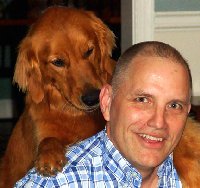The oldest book Amazon.com has on human body language is the 1970s book Body Language by Julius Fast. That was when we humans became conscious of body language. While we’re relatively new to its existence (40 years), your dog is a veteran master. Other than the occasional throaty sound, body language is the primary resource for understanding dog communication! For a happier, more loving dog you have two choices: asking your dog to completely understand you (they are good but not that good), or for you to better understand your dog.
Writing is an imperfect vehicle for describing emotions, so I’ve included some pictures in this article. Generally, dogs show emotions in consistent ways. However every dog is different and will have some uniqueness to his expression.
Simple Thinking
Dogs are thankfully simple in their thinking. That hard stare you get at the end of the day probably isn’t about the stock market crash but DINNER. It is great fun to guess what your dog is thinking: “She is mad at me” or “He wants to eat from his special bowl.” That is the human interpretation of the body language, however dogs always work from the basics of eating, sleeping, socializing and breeding.
These communications are not always easy to read, after all Cesar Milan of “Dog Whisperer” gets bitten occasionally. Moreover a dog can change an emotional state in a split second. Because he does not have the ability to reason, instinct guides him. That’s called “in-the-moment” thinking. Does this make all dogs dangerous or unstable? Not at all. Mother Nature has taken time to instill a guiding character into each breed. Rarely does a dog act out of character.
Body Language Signs
Below are many of the emotional and body language clues that will help decipher the canine code. Beware, within a single emotion there can be conflicting clues. For instance in chasing behavior the signs can be quiet and still, or excited panting. Generally, three or more concurrent signs validate the emotion state.
Aggression
Drawing his lips back to expose teeth, snarling.
Growling or strong barking.
Ears pinned back close to his head.
Tail pointed straight out or up.
Narrowed eyes and a hard stare along with quiet stillness.
(Getting ready for an ambush or fight.)
Jaw snapping.
The body is tense, rigid.
Charging or running toward the prey.
Head held low.
Raised hair on the back and neck.
Alertness
Quiet and calm.
Eyes wide and focused.
Ears are perked up, rotating to focus on sounds.
The mouth is closed or barely open.
The head is on a swivel.
Attuned to any movement or sound.
Air scenting.
Anxiety
Whining or “crying.”
The body is tense and lowered into a submissive position.
The ears are about half way back but not pinned.
The eyes are slightly narrowed.
The mouth is closed.
The tail is low or between the legs.
Movement of the tongue similar to licking.
Trying to look small or looking to escape.
Seemingly uncomfortable.
Exhibits self-protective aggression.
Unhappy.
Chasing Behavior
Hard stare, very focused.
Quiet and still, or excited panting.
Stalking.
Crouched and ready to run.
The ears are perked up and pointing forward.
Sudden pulling on the leash.
Eyes are wide open.
The mouth is open slightly.
The tail is pointed straight out and still.
Eagerness or Excitement
The mouth is open slightly.
Excited barking.
Fast panting.
Wiggling the body or prancing around.
Full-bore wagging of the tail.
The eyes are open wide.
The ears are perked up and pointing forward.
Jumping up.
Dominance
Growling or grunting assertively.
Demanding.
Tail is high, stiff with short strokes.
Standing very tall.
Staring.
Ears are pointed forward or straight up.
The mouth is closed.
Taking the upper physical position (i.e., standing over another dog).
Bumping or pushing.
Fear
Flinches when touched.
Stand-offish.
Shivering or trembling.
He might yelp, growl or whine.
The body is in a low, submissive position.
The ears are pushed back and held close to his head.
Eyes are narrowed.
His lips are drawn back, possible exposing his teeth.
The tail is tucked between his legs.
Strong flight instinct.
Cowering.
Happiness or Playfulness
Barking loudly.
Bouncing, jumping, circling or running back and forth.
Excitedly panting.
The body is relaxed.
The ears are perky and pointing forward.
The mouth is relaxed and slightly open.
Rapid, full-stroke tail wagging .
Crouched with front legs spread.
Excessive drooling.
Portions reprinted by permission from TheDogPark.com
Portions reprinted by permission from TheDogPark.com

















